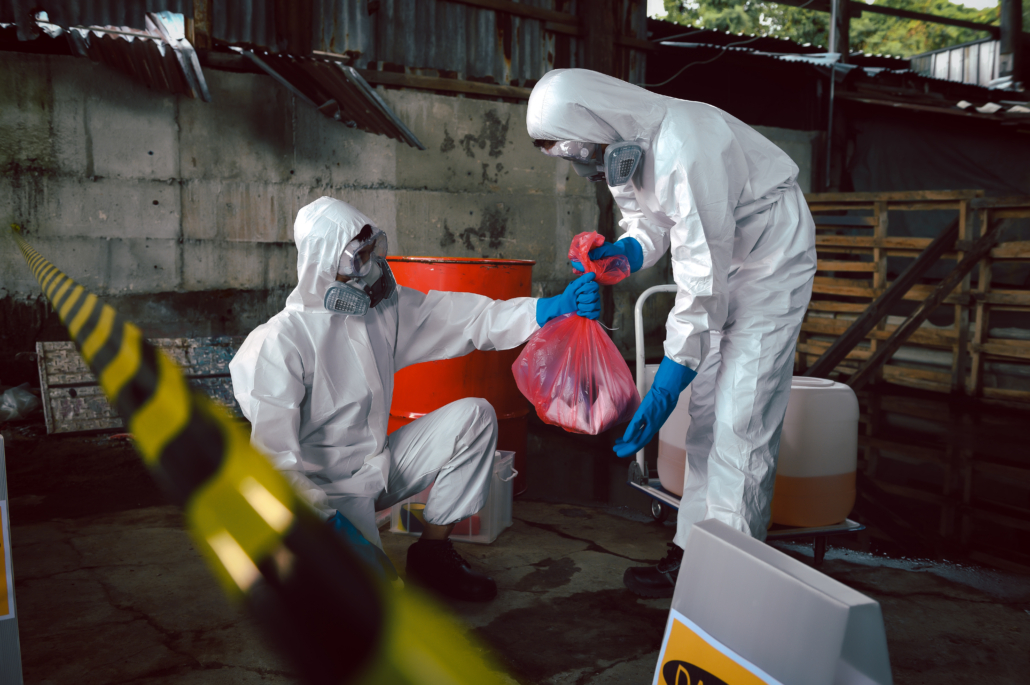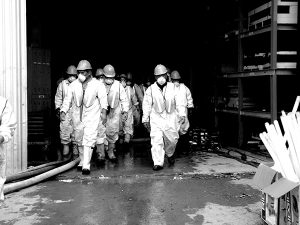Biohazard Removal: Safe Handling and Disposal of Hazardous Products
Biohazard Removal: Safe Handling and Disposal of Hazardous Products
Blog Article
Professional Biohazard Cleansing and Purification for Blood, Bodily Fluids, and Hazardous Products
The prospective health dangers associated with exposure to biohazards emphasize the vital demand for precise handling and detailed clean-up. As we browse the intricate landscape of biohazard clean-up, understanding the nuances of guidelines, compliance, and the specific devices at play becomes necessary in ensuring a thorough and safe purification procedure.
Wellness Risks of Biohazard Exposure
Exposure to biohazards positions substantial health dangers that can lead to serious effects for people and areas alike. Biohazards encompass a large array of organic materials, consisting of blood, physical liquids, mold and mildew, bacteria, viruses, and other potentially infectious materials. When individuals enter into contact with these biohazards, whether through accidents, improper handling, or environmental exposure, they face the risk of contracting major ailments or illness.
One of the primary health risks related to biohazard direct exposure is the transmission of transmittable illness. Bloodborne microorganisms such as HIV, hepatitis B and C, and different bacteria can be present in biohazardous products, posturing a straight danger to human health and wellness. Inhaling airborne biohazards like mold and mildew spores or entering contact with polluted surfaces can also bring about respiratory system concerns, allergies, and other damaging wellness effects.
In addition, biohazard exposure can have lasting health implications, with some conditions materializing years after the preliminary call (Blood Cleanup). For that reason, it is critical to focus on correct biohazard cleaning and purification to mitigate these health and wellness risks and ensure the safety and security of individuals and areas

Specialized Educating for Biohazard Cleanup
When it pertains to handling biohazard clean-up effectively and securely, specialized training plays a fundamental function in making certain proper decontamination treatments are adhered to. Biohazard cleanup needs certain expertise and skills to efficiently mitigate dangers related to bloodborne virus, physical fluids, and hazardous materials. Experts educated in biohazard cleaning undertake rigorous direction on how to securely deal with, eliminate, and take care of biohazardous materials to stop contamination and direct exposure.
Specialized training for biohazard cleanup covers a variety of important topics, including proper personal protective equipment (PPE) usage, bloodborne pathogen awareness, decontamination techniques, and contaminated materials disposal procedures. Individuals educated in biohazard cleaning are equipped with the required knowledge to examine contamination degrees, determine potential hazards, and carry out ideal cleanup procedures in compliance with regulatory standards.
Constant training and education are vital in the area of biohazard cleanup to stay updated on the most up to date purification modern technologies, safety and security methods, and laws. By purchasing specialized training, biohazard cleaning experts can efficiently reply to emergency situation cleanup circumstances and protect both public health and the setting.
Value of Proper Purification Methods
Utilizing correct decontamination strategies is vital in biohazard cleanup to successfully reduce and eliminate hazardous products health threats. Reliable decontamination not just guarantees the elimination of visible traces of blood, physical fluids, and other biohazards yet also targets unseen microorganisms that might pose major health hazards if not correctly eradicated. By following rigid decontamination procedures, educated professionals can substantially reduce the threat of exposure to harmful look at more info microbes, infections, and bacteria that might lead to infections or conditions.
Appropriate purification strategies entail using specialized devices and disinfectants that are particularly created to reduce the effects of biohazards effectively. Detailed cleaning and sanitation of polluted locations are vital to stop the spread of microorganisms and make certain a risk-free atmosphere for passengers. In addition, the right disposal of biohazardous waste adhering to decontamination treatments is essential in avoiding contamination of various other surfaces or individuals.

Devices and Tools for Safe Cleanup
When dealing with blood, bodily fluids, or unsafe materials, biohazard cleansing professionals depend on specialized equipment to reduce direct exposure risks and extensively decontaminate the afflicted location. Additionally, biohazard cleaning packages containing anti-bacterials, absorbent products, and biohazard crime scene cleanup youtube bags are made use of to safely get rid of and include of contaminated things.
Advanced cleansing devices like hospital-grade anti-bacterials, HEPA-filtered vacuums, and fogging machines are used to sterilize surfaces and eliminate biohazards efficiently. Specialized tools such as sharps containers and biohazard waste disposal containers are used to safely manage sharp items and biohazardous waste products. By utilizing the best devices and tools, biohazard cleansing professionals can make sure an extensive cleaning process that focuses on safety and decreases health risks for both workers and residents of the afflicted area.
Laws and Conformity in Biohazard Cleansing
Proper adherence to regulations and compliance standards is critical in biohazard cleaning to guarantee the safety of both personnel and the environment. Government agencies such as OSHA (Occupational Security and Wellness Administration) and the EPA (Environmental Security Firm) have established certain standards for biohazard cleaning treatments to reduce wellness dangers article source and environmental contamination. These policies cover a variety of facets consisting of the handling, transportation, and disposal of biohazardous products, in addition to the required training and protective tools needed for employees entailed in the cleanup procedure.
Biohazard cleaning business should stay current with these guidelines to ensure that their operations satisfy the required safety criteria. Failure to adhere to these regulations can lead to serious consequences, consisting of fines, legal activity, and threatening the health of people and the environment. By adhering to rigid regulations and conformity steps, biohazard cleansing business can effectively mitigate dangers and ensure a secure and extensive cleaning process for all events included.
Final Thought
Finally, biohazard cleansing and purification require specific training, correct techniques, and adherence to laws. Direct exposure to blood, bodily liquids, and unsafe products poses considerable wellness threats, making it critical to make use of the best equipment and devices for risk-free cleaning. By adhering to rigorous methods and guidelines, experts can successfully alleviate the risks related to biohazard direct exposure and make sure the safety of both themselves and others.
As we navigate the elaborate landscape of biohazard cleanup, recognizing the subtleties of regulations, conformity, and the customized equipment at play ends up being crucial in ensuring a detailed and secure decontamination process. (Blood Cleanup)
When it comes to handling biohazard cleanup effectively and safely, specialized training plays an essential function in making sure appropriate purification procedures are complied with.Using appropriate decontamination methods is important in biohazard clean-up to efficiently reduce and eliminate hazardous materials wellness threats. In addition, biohazard cleansing sets including disinfectants, absorbent materials, and biohazard bags are used to securely dispose and contain of infected things.
Federal government agencies such as OSHA (Occupational Safety and Wellness Management) and the EPA (Environmental Defense Firm) have established particular guidelines for biohazard cleanup treatments to lessen health and wellness risks and environmental contamination.
Report this page